
MILDENHALL BRANCH HISTORYThe Mildenhall branch arrived relatively late on the railway scene, and it could be said that its existence was owed in part to the ill-fated Newmarket & Chesterford Railway (N&C). In 1847 the N&C, with its main line yet to be opened, sought powers to extend beyond Newmarket to Thetford, linking up with the Norfolk Railway, and to Ely and Bury St Edmunds. Meanwhile, the Royston & Hitchin Railway (R&H) was creeping north-eastwards and the Eastern Counties Railway (ECR) was fearful of a link-up between the R&H and the N&C at Chesterford. These schemes would have provided a route from London reaching into Norfolk and Suffolk via Newmarket and, had the schemes come to fruition, they would have been a serious threat to the ECR. It was for this reason the ECR, on and from 2 October 1848, took over the Newmarket Railway - as the N&C had by then become - on lease. Relations between the Newmarket Railway and the ECR were never good, even subsequent to the lease agreement. This resulted in the Newmarket and Norfolk Railways reaching an agreement to route all through traffic via Newmarket. The ECR, with its eyes and ears constantly alert, scuppered this plan by offering the Newmarket Railway more favourable terms on the condition that it abandoned its extension plans of 1847. The Newmarket accepted and as a result their plan for extensions to Ely and Bury St Edmunds were abandoned for, as it turned out, the time being. Ely and Bury St Edmunds were later connected to Newmarket; the former by the Ely & Newmarket Railway and opening on 1 September 1879, under the auspices of the Great Eastern Railway which had been formed in 1862, and the latter by new powers sought by the Newmarket Railway in 1852, with the line opening in 1854. The proposed direct route between Newmarket and Thetford was never to be. Had it been built, it is thought that the route would have been via Kennett, Herringswell and Thetford St Mary (a parish in the south-west of Thetford) with a station serving Mildenhall, probably located in, or to the south of, Barton Mills. The result of this non-starter was a large area bounded by Cambridge, Newmarket, Bury St Edmunds, Thetford and Ely being devoid of a penetrating railway. This problem was frustrating Charles Allix (1842-1921) who had inherited Swaffham Prior House and all that went with it. As well as those responsibilities he was a Quarter Sessions Vice Chairman, magistrate, antiquarian and, as we shall see, a man determined to have a railway serving his region. Mr Allix approached the GER in 1867 with a view to the construction of a railway from the Swaffham Prior and Burwell areas into Cambridge. The GER rejected the proposal, citing the prospect of predicted poor financial returns. This was very likely true but the dire financial position of the GER itself at that time was probably the predominant reason.
Not one to be put off easily, Mr Allix then looked elsewhere. Apparently* without realising the London & North Western Railway (LNWR) had access to Cambridge station only by agreement with the GER, Allix approached the former company in the hope they would be interested in his proposal. Needless to say, the London & North Western, not wishing to upset the GER, declined. The LNWR had its own route into Cambridge which joined the GER immediately south of Hills Road (a few chains south of Cambridge station) for access to the station. The LNWR never operated beyond Cambridge, but had this company taken up Allix's proposal the LNWR would have needed to use GER tracks rather more extensively. This, plus any trade gained by the LNWR - and thus lost by the GER - from what was to become the Mildenhall branch would have caused relations between the GER and LNWR to deteriorate. The LNWR foresaw these problems and thus wisely declined Allix's proposal. *It is unclear whether Allix genuinely failed to realise the situation between the LNWR and GER or if his proposal to the LNWR was a deliberate ploy to panic the GER into agreeing to build the railway to Swaffham Prior and ultimately beyond. By all accounts Allix was a determined and, perhaps, over-enthusiastic optimist but history makes it abundantly clear that he was by no means a fool. The answer to the question regarding his approach to the LNWR is therefore left to the reader to decide. The next proposal for a railway serving the Mildenhall area was for the ‘Ely & Bury Saint Edmunds Light Railway’, this company's deputy chairman being none other than Mr Allix. This railway was incorporated by an Act of 1875 and a reasonable amount of information has survived about it. Its title is curious; it was quoted as above, or without the word ‘Light’ or with ‘Light’ in brackets. This was also long before the Light Railways Act of 1896. Plans for the Ely & Bury, as we will call it, were quite advanced and the precise route it would have taken is known. From Ely the route was to have been Soham, Fordham, Isleham, Freckenham, Worlington, Barton Mills, Mildenhall, Icklingham, West Stow, Lackford, Flempton, Culford, Fornham St. Genevieve and Timworth. At Timworth the route would have joined the Bury St Edmunds - Thetford line, which opened in 1876, at a junction just south of Ingham. The locations mentioned are the parishes through which the line would have passed and not necessarily locations at which stations would have been provided, but we can nevertheless be certain that a station would have been provided to serve Mildenhall. The Ely & Bury appears to have been the first serious attempt to provide the town of Mildenhall with a railway but, as was often the case with nineteenth century railway schemes, it eventually failed partly for financial reasons and partly owing to the construction of the Ely & Newmarket (and thus to Bury St Edmunds) line. During November 1879 an Act of Abandonment application was put before Parliament and this appears to have been passed in December 1880. The date of November 1879 is significant, being just two months after the opening of the Ely - Newmarket line.
At this point in the story it should be mentioned that Mildenhall did in fact have a railway station from as early as 30 July 1845. Referred to variously as ‘Mildenhall’ or ‘Mildenhall Road’ in company records and various timetables, it was situated on the Ely - Thetford line in a remote spot some seven miles from the town of Mildenhall. With the opening of the Fordham - Mildenhall line in 1885, this station was renamed Burnt Fen and in 1905 to Shippea Hill. This last name change is said to have been to placate local farmers who dispatched their potatoes from the station, and they could obtain higher prices for ‘hill’ than for ‘fen’ potatoes. It remains open today although the service is sparse, to put it mildly. Meanwhile back at Swaffham Prior, Mr Allix had remained determined to see his region provided with a railway to with a railway to help revive local agriculture which was experiencing economic hardship. Allix therefore made another attempt to get a railway built from Cambridge to a junction with the Ely - Newmarket line. This, too, failed through lack of backing. It is often said that every cloud has a silver lining, as Mr Allix was soon to discover. The railway north of Cambridge, and onwards to Brandon, had suffered problems with flooding, and during 1878 serious disruption occurred once again. This time the GER 'brass' realised that Mr Allix's proposal could, if built, help to alleviate the problems, and thus the Mildenhall branch was finally born. For the next couple of years there was apparently, records show, quite a lot of dithering over the proposed junction at Cambridge. Mention was made of ‘Chesterton Junction’, ‘Chesterton’ and ‘near Chesterton’ before mention was finally made of ‘Barnwell’. Barnwell and Chesterton were, at that time, two separate wards of what is today the City of Cambridge (Cambridge was then still a town) and the two railway junctions were, indeed still are, only three-quarters of a mile apart. The apparent dithering on the part of the GER directors was therefore most likely to have merely been the result of a lack of precise local knowledge than of anything else.
The GER's realisation that Mr Allix's plans would create a useful alternative route in the event of the Ely - Thetford route being out of action would be true only if the Mildenhall branch were to be constructed beyond Mildenhall to Thetford. Yet it is clear from surviving records that the GER always intended Mildenhall to be the terminus, or at least Mildenhall was as far as the GER was prepared to fund the line's construction. Not too much significance can be placed on the fact that Mildenhall station was built as a through station; this being by no means unusual for rural branch termini although it was often done with future extension in mind. Notwithstanding this, Mildenhall was provided with a turntable and pit but no other locomotive facilities. This was rather unusual for a branch terminus and may suggest a possible future extension was not totally ruled out. The directors of the GER had noted that flood protection and repairs to flood damage on the Ely - Thetford line, in particular near Lakenheath, were wholly inadequate and the situation could not be allowed to continue. At this point things become rather mysterious. While plans to build the Mildenhall branch were stampeding ahead, the GER had meanwhile re-engineered the vulnerable sections of the Ely - Thetford line. The GER therefore viewed an alternative route - i.e. via Mildenhall - as no longer warranted, and this was the reason the branch never progressed beyond Mildenhall. In remembering a diversionary route south-west from Thetford was the reason for the GER eventually agreeing to build the line, the mystery is why, with that reason now void, construction of the line continued; this question can be asked especially of what, in effect, became the truncated stub from Fordham to Mildenhall. junctio_old11.jpg)
Barnwell Junction looking south-west in July 1969. 'COND ' on the van body means 'condemned', in other words withdrawn from service. It was standard BR practice to so-mark withdrawn stock but the symbol later became a cross in a circle. Note that the surviving up line has by this time been relaid with concrete sleepers at this point.
Photo by John Mann As built, the Mildenhall branch, or rather the Fordham - Cambridge section, had potential as a diversionary route only for the Cambridge - Ely and Fordham - Newmarket - Cambridge routes and it was indeed used as such on a number of occasions. Perhaps this potential became the justification for proceeding with the Mildenhall branch. Furthermore, of course, from 1876 another diversionary route was available from Thetford to Cambridge via Bury St Edmunds although the track layout at Thetford would have proved inconvenient for the purpose.
Back in the boardroom, the GER was inviting tenders for construction of the Mildenhall branch. With Royal Assent having been received on 18 July 1881, the relevant Act provided for three sections of railway: Barnwell - Swaffham Prior; Swaffham Prior - Fordham; Fordham - Mildenhall. Henry Lovatt, of Wolverhampton, won the contract for the entire route with his tender of £76,327 11s 8d, but for reasons which are unclear this did not include the provision of fencing for which an additional 2s 0d per mile was paid. Much of the fencing consisted of posts made from redundant sleepers with one end cut to point, so perhaps the GER (assuming this fencing was at their instigation) was looking at saving money by providing its own materials, and in doing so entered into a separate agreement with the contractor. Some of this fencing can still be seen today, especially towards the Cambridge end of the former route. During October 1882 the contractor moved in to mark out the course of the line and on a cold and miserable Wednesday 3 January 1883 some GER grandees and Mr Allix assembled at, unsurprisingly, Swaffham Prior for the usual 'cutting of the first sod' ceremony. The spade, suitably engraved as was often the case, still survives. ‘Swaffham Prior’ is the correct form of the village name, and it was used by the GER; later, the LNER and BR adopted the incorrect ‘Swaffhamprior’ form.
The contractor is known to have used four locomotives on the construction work. Of these, one was a Manning-Wardle 0-6-0T Godfrey and another was a Hunslet machine Scot. The identity of the other two locomotives is not known, other than their names Berkeley and Falcon. Construction was swift and only a few minor legal matters needed dealing with. During 1883 the signalling contract was awarded to Messrs McKenzie & Holland with signal boxes costing £75 10s each, while local tradesmen were recruited for the erection of station buildings. The station building at Swaffham Prior was built in a somewhat different style from others in order to mirror the design of Swaffham Prior House, the Allix residence. The GER was keen to provide bridges, as opposed to level crossings, wherever possible. This seems to have applied especially to the Fordham - Mildenhall section, with some revisions on the Barnwell - Fordham section; for example, a bridge was provided at Fen Ditton (at the site of the later halt) where a level crossing was originally intended. Nevertheless, the 19m 3ch route between Barnwell Junction and Mildenhall had no fewer than 70 level crossings. To put this into a less dramatic perspective, only seven of these were on public roads, the remainder being foot or occupation crossings.
Major General Hutchinson inspected the Barnwell - Fordham section on behalf of the Board of Trade on 28 May 1884. Whilst the inspector found the general standard of construction to be high, a number of issues with fencing and signalling were noted. Permission was given for the line to open providing these were dealt with quickly - which they apparently were. The inspector also required all trains to call at all stations. Inspection of the Fordham - Mildenhall section, on 28 March 1885, went well, with only a couple of problems noted at Fordham station including the lack of a subway or footbridge (the latter was provided in the event) and the position of the water column on the down platform. The latter was a safety issue as the column was said to be too close to the platform edge and required either the moving of the column or the shortening of the platform. It is not entirely clear what, if anything, was done as photographs taken during BR days show the water column still near the platform edge but mounted on the platform ramp. Those two issues aside, the inspector was impressed with the general standard of construction and gave his consent to the immediate opening of this section. The track at the outset was cinder ballasted: another GER economy measure, and one which was perfectly adequate for a branch line. Limestone ballast gradually appeared over the decades but odd sections of track remained cinder-ballasted to the end. Technically the line was two separate branches; Barnwell Junction - Fordham South Junction and Fordham North Junction - Mildenhall. The Barnwell - Fordham section opened to traffic on 2 June 1884, with the Fordham - Mildenhall section following on 1 April 1885. The line was built with provision for future doubling of the track but, as with so many other lines built with this in mind, it was never to be. Stations were built at Barnwell Junction (adjacent to the main line but with platforms serving only the branch), Quy, Bottisham, Swaffham Prior, Burwell, Isleham and Mildenhall. Bottisham was renamed Bottisham & Lode on 22 April 1897; this station was in Lode but some two miles from Bottisham. Fordham station, of course, already existed. Of these stations Barnwell Junction, Bottisham & Lode, Burwell, Fordham and Isleham had two platforms. Isleham, incidentally, is pronounced ‘Eyes-lam’. Prior to the opening of the branch, Fordham station was named ‘Fordham & Burwell’. The renaming to simply ‘Fordham’, since Burwell now had its own station, occurred concurrently with the opening of the Barnwell - Fordham section. Fordham station was quite remote from the village it served, being just over one mile away from the village centre by road. Passenger services on the branch were never frequent although in the early years they were more or less on a par with other rural branch lines. Despite the possibilities offered by the connection at Fordham with the Ely line, the original timetable offered only four Cambridge -Fordham (and return) services stopping at all stations conforming to the Board of Trade inspector's requirements. Later that year, 1884, this was increased to five return journeys, Thursdays excepted. On that day, Ely market day, advantage was taken of the connection at Fordham and one train continued to Ely, the 12.30pm ex-Cambridge, which returned from Ely at 3.30pm. The timing of this service appears rather strange; considering that Ely station is not especially conveniently sited, passengers would not have had a great deal of time at the market - perhaps just over one hour, but presumably this was deemed adequate. With the opening of the Fordham - Mildenhall section the following year, five return journeys travelled the full length of the line although on Thursdays one did not operate between Cambridge and Fordham, and vice versa. Tuesdays and Thursdays saw an additional Mildenhall - Fordham (and return) service but at different times on each of those days. Timetables do not indicate that these trains continued to/from Ely so they were probably connecting services. By 1890 there were additional Thursdays-only/excepted services plus one mixed train. Goods trains were provided from the outset but the 1890 working timetable appears to be the earliest surviving printed material showing details.
From the opening of the Fordham - Mildenhall section, two locomotive crews lodged in the Mildenhall area and later the GER provided two cottages at Mildenhall station for them. These cottages were located on Station Road and on the opposite side of the track to the station platform. They survive today, albeit extended, and look very smart indeed. Adams K9 0-4-2T locomotives are known to have been outstationed at Mildenhall in the early years. We have already seen that Mildenhall was provided with a turntable and pit, the latter located on the turntable road, but no other locomotive facilities. Therefore the precise arrangements for locomotives kept overnight at Mildenhall are not entirely clear. We do, however, know the locomotive which stayed overnight at Mildenhall returned to Cambridge with the first train of the day at 7.45am. Presumably carriage stock would also have been stabled overnight at Mildenhall. In the early years this stock consisted of 4 and 6-wheeled gas-lit vehicles, unheated and for which facilities for footwarmers were provided at Mildenhall: all quite typical for a rural branch of the time. Later, a Saturday-only late train was also run for a time with arrival at Mildenhall around midnight. This train returned empty to Cambridge via Ely as branch signal boxes closed after the passage of the final train of the day. Things trundled on in much the same fashion until the first decade of the twentieth century. By, or during, this period locomotives such as the Y65, Y14 and T26 (LNER/BR classes F7, J15 and E4 respectively) had become commonplace on the branch with other small locomotive types appearing from time to time, soon followed by the larger G58 class (LNER/BR class J17). Despite increases in traffic, especially following the opening of the Fordham - Mildenhall section, the GER was perpetually worried about poor traffic receipts for the line. The GER calculated revenue on a 'per mile' basis balanced against costs and used the seemingly unjust method of making 'per mile' calculations in comparison with similarly arrived at figures for their main lines. As a result a number of economies were made on the Mildenhall branch over the years, including transferring responsibility for a large number of road overbridges to the County Council and replacing some signal and station lamps with cheaper to run alternatives. In 1914 the GER's James Holden decided to experiment with Push - Pull trains as a further cost-cutting measure. These trains, variously described as ‘Push – Pull’, ‘Motor Train’ or ‘Auto Train’, consisted of a locomotive semi-permanently coupled to a coach with a driving compartment at its outer end (driving trailer). Further coaches could be added between the locomotive and driving trailer providing they were fitted with through control equipment. The standard formation on most railways was locomotive plus two coaches. 7.jpg)
The view along the trackbed towards Swaffham Prior in May 1976. Pallets proliferate and
undergrowth usurps. Photo
by David Burrows from his Flickr photostream
Holden borrowed drawings from the London, Brighton & South Coast railway of their Westinghouse (compressed air) Push - Pull control system and converted Y65 2-4-2T No.1311 and two clerestory bogie coaches into a Push - Pull train with further conversions following later. This train operated trials in service on the Mildenhall branch from 5 October 1914 but the experiment was not considered a success. The train was sent to the Somersham - Ramsey branch and later ended up in the London area on various routes. The inherent problem with Push - Pull trains was the difficulty in adding extra coaches at busy times and their inability to operate as mixed trains. That said, Push - Pull trains operated highly successfully on many lines across the country and some survived into the 1960s. Whilst ideal for higher frequency shuttles on short routes, it is difficult to see how the GER thought this train would bring any real economies to the Mildenhall branch. The First World War brought considerable extra goods traffic to the line as a result of the government urging farmers to produce more food, but otherwise the war had little effect. Despite the wartime Railway Executive Committee pressing the railways to make economies (meaning, in particular, reductions to passenger services), services on the Mildenhall branch plodded on much as previously. By 1916 there were five trains each way and one goods train per day, Monday - Saturday. Certain passenger trains were permitted to include goods, horse or cattle wagons providing the wagons were Westinghouse piped. The permitted attachment of goods and other vehicles to passenger trains, if necessary, appears to have been a wartime contingency. Timetable details are patchy but that for 1916 clearly indicates that the overnight stabling of locomotives at Mildenhall had ceased by this time and subsequent timetables indicate the same. After the end of World War One, a story familiar across the country was of the sudden availability of large numbers of ex-military road vehicles. These were snapped up at bargain prices and used for haulage or were adapted as buses and, in a few cases, taxis. Meanwhile, Mr George Mansfield, of Burwell, had been busy running his cobbler’s business. At an unknown date, Mr Mansfield had acquired a Model T Ford taxi and, post-war, a Napier vehicle which had been used as an ambulance during hostilities. This was converted into a bus, and so was born what became known as the Burwell & District Motor Service (B&D); a company which survived until 1979 when the Mansfield family sold out to the Eastern Counties Omnibus Company (ECOC) which had been formed in 1931. B&D's main route was their Service 1 between Burwell and Cambridge which ran daily and with a reasonable frequency. Unlike the railway, with many of its stations sited in hopelessly inconvenient locations, B&D's buses served the heart of the villages en route and then deposited passengers right in the centre of Cambridge; Cambridge railway station is over a mile from the city centre. Nevertheless, the perpetually poor train services probably meant that B&D's buses starved the Mildenhall branch of any potential extra business rather than drawing existing business away from it. B&D also operated a Service 11 from Mildenhall to Cambridge. This ran only on Monday, Wednesday, Saturday and Sunday but was to be one of a number of bus services suspended at the outbreak of war in 1939.
While Mr Mansfield was beavering away in Burwell, the population of rural communities had been in decline. This had been the case for many years and continued to be so as people, especially young people, abandoned the rural life to seek work in larger, better connected villages and, in particular, towns and cities. The depression during the early twentieth century also took its toll. By 1922 the timetable showed just three trains per day operating via Burwell, with the first down train not departing from Cambridge until 10.30am. There was, however, an earlier service to Mildenhall via Newmarket: the 6.47am ex-Cambridge arrived at Mildenhall at 7.44am. This train then formed the first departure of the day from Mildenhall at 7.55am to Cambridge via Burwell. The final down train from Cambridge departed at 7.36pm and then formed the 8.40pm up service from Mildenhall to Cambridge via Newmarket. In an attempt to encourage more business, the GER opened three halts on the line at Fen Ditton, Exning Road and Mildenhall Golf Links; all three opened on 20 November 1922 (but one source erroneously gives 20 November 1920 for Fen Ditton). Fen Ditton Halt, as a result of boundary changes, was later actually just within the City of Cambridge. The halts were all located on the up side of the line, i.e. on the left side of Cambridge-bound trains, and on the Cambridge side of adjacent road overbridges (bridges 2236, 2242 and 2257 respectively). They were rudimentary affairs: a footpath led down the embankment from the road to end at a low cinder 'platform' faced with what appears to have been old sleepers. These ‘platforms’ were no more than six or seven inches high. Each halt had a standard GER nameboard; wooden with wooden letters affixed thereon. An oil lamp was provided, and at various times posters were pasted onto a board attached to the bridge wings. The bridges themselves provided the only protection from inclement weather, although trespass notices forbade waiting passengers from sheltering beneath the bridge arches. The footpaths cut into the embankments must have been precarious during times of ice and snow. It appears that gates were provided at the top of the footpaths. The Railways Act of 1921 saw the GER become part of the London & North Eastern Railway (LNER) on and from 1 January 1923. On this date Mildenhall Golf Links Halt was renamed Worlington Golf Links Halt. The ‘Halt’ suffix appeared in timetables and on tickets but not on the halt nameboards. Of these three halts, Exning Road, actually located on the outskirts of Burwell, saw very little patronage, but the other two appear to have seen a reasonable amount of use in their early years. All three halts remained open until the line closed to passengers in 1962 but following the introduction of diesel trains in 1955 evidence suggests train crews treated the halts as request stops and, if nobody wished to board or alight, did not bother to stop even though most trains were timetabled to do so. One photograph exists of a DMU sneaking through Worlington with its driver apparently having a good look up the footpath for any intending passengers. As the halts had no proper platforms, the GER introduced carriages fitted with retractable steps. Such carriages were always brake types and the steps were interlocked with the train brakes to prevent movement with the steps extended. With the opening of the halts, a notice was also affixed to the relevant carriage informing passengers they must board that particular vehicle if they wished to alight at the halts. Passenger timetables also instructed passengers to or from the halts to use the ‘special car’. Destination boards were affixed just below the cantrail but it is not clear if these were introduced at the same time as the halts or if they predated them, although they are known to have been used during the earlier Push-Pull experiment. At least one photograph exists showing both destination and halt boards in situ, with the Golf Links halt being stated simply as ‘Mildenhall Golf’. Initial conversions were of increasingly antiquated 6-wheeled stock. One peculiarity of the 6-wheeled stock, specifically a composite type, was the adaption of a third class compartment as the entrance to the first class accommodation. In later years, ex-main line bogie stock and then Gresley bow-ended corridor stock appeared on the branch and this was, of course, also kitted-out for use at the halts. This stock survived until diesel trains took over and the final such stock in use was dedicated set No.109. Because the halts lacked booking facilities the GER introduced ‘conductor-guard’ working, and for this purpose the carriage stock, which at the time was non-gangway, had to be modified to allow the guard to move through the train. Apart from the obvious connection between individual vehicles, the interior layout was also heavily modified. Some sources state the initial conductor-guard stock carried the short-lived crimson livery introduced by the GER in 1919. With the halts being unstaffed, the arrangements for filling with paraffin, lighting and extinguishing the oil lamps are not known but presumably platelayers, who walked the track for inspection purposes, filled the lamps whilst lighting and extinguishing was undertaken by train guards. Unlike at stations, oil lamps at the halts did not have the halt name on the casement glass. When the initial cost of the halts is added to the recurring cost of modifying dedicated coaching stock to suit, it is doubtful whether their provision was financially justified. Tickets from Quy were also issued on the train. It is unclear when this economy measure was introduced but it was obviously after 1922 and was probably among the economies made by the LNER during the 1930s; the winter 1937-38 public timetable indicates that tickets from ‘Quy and the Halts’ should be obtained on the train.
Under the LNER things carried on much the same until 1926 when the miners’ strike of that year (a continuation of the General Strike) forced a reduction in services to just two trains each way. By 1928 the service had improved, with four up and three down trains, but with final up train of the day continuing to operate via Newmarket. One change at this time was the first down train of the day reverting to run via Burwell but omitting stops at Quy and the three halts. It would appear that this was done for timing and pathing reasons. The LNER viewed the former GER system it had inherited as something of a millstone around its neck and considered the withdrawal of a number of branch passenger services in the east of England. As a consequence the Somersham - Ramsey, Ely - St Ives and Denver - Stoke Ferry branches lost their passenger services in 1930. It is thought the Mildenhall branch was also considered for closure to passengers but, as events were to prove, it somehow managed to survive. The likely, but unconfirmed, reason was probably the line's potential as a diversionary route between Barnwell and Fordham. At around the same time the LNER made further economies by reducing the status of Quy and Swaffham Prior signal boxes to shunting frames, being operated by a porter/signalman when required. In 1935 these two boxes were abolished altogether and at the same time the goods loops through these stations were lifted. The latter move left the platform roads at these stations with seemingly peculiar kinks where plain track had replaced points, and this layout survived to the end. During the 1930s a number of air bases were - or had already or soon were to be - opened in the region. Among the many, all too numerous to mention here, were Bottisham, Lakenheath, Feltwell and Mildenhall; the last-named opened in 1934. As a foretaste of the present day, the 1937-38 timetable showed bus connections from a number of stations; Cambridge, Barnwell, Burwell, Fordham and Mildenhall. Strangely, a bus connection was also shown for Exning Road Halt. The LNER adopted this practice throughout its system, drawing attention to services operated by ‘associated’ bus companies in which the railway company had a financial interest. In some, perhaps most, cases closure of passenger lines by the LNER from the late 1920s relieved the company of operating unremunerative routes, but they benefited from the fares paid by the passengers if they transferred their patronage to the ‘associated’ bus operator. In the case of the Mildenhall branch, with war clouds gathering this bus connection information might have been helpful to military personnel who, at the time, were beginning to descend upon the region. World War Two broke out in September 1939 and this brought some increase in traffic to the Mildenhall branch. As with the First World War, the line saw an increase in agricultural traffic and, as indicated above, in military personnel using the line. Goods traffic vital to the war effort, i.e. bombs, ammunition and other equipment was generally routed from Cambridge via Newmarket during the night. Nevertheless, the need for the railways to focus assets where they were most needed meant that services on the Mildenhall branch remained poor insofar as published times were concerned. For the duration there were still three trains per day each way with the first down train operating via Newmarket. Two goods trains per weekday were provided, one of which commenced from sidings at Coldham Lane Junction, Cambridge. The operation of these trains was relatively complex compared to peacetime, with specific yards and sidings being served only on certain days - as well as other complications. A couple of war-related incidents are worth mentioning. On 4 December 1940 at around 5pm a Mildenhall-bound passenger train was attacked by an enemy aircraft near Exning Road Halt, first by bombing and then by machine-guns. The bombs damaged the track behind the train but the machine-gun attack caused a number of casualties among the passengers. The train escaped and arrangements regarding the casualties were made at Fordham. Branch trains were also attacked on a number of other occasions but with negligible effect. On a brighter note, on 13 June 1942 His Majesty King George IV and Queen Elizabeth (later, Queen Elizabeth The Queen Mother) arrived at Swaffhamprior station as part of a tour of the region.
After the war things returned to pretty much the way they had been previously. On and from 1 January 1948 the Mildenhall branch became part of the Eastern Region of British Railways. Bradshaw for that date shows three trains each way: down trains at 6.33 and 10.28am, and 4.27pm, and at 7.42 and 11.50am and 5.48pm in the up direction. The 6.33am ex-Cambridge omitted the halts, but did call at Quy, and all trains ran via Burwell. By the 1950s there were four passenger trains per day, the final departure being the 9.00pm from Mildenhall, omitting Worlington and operating via Newmarket to Cambridge. At the same time, the first down service of the day still omitted the three halts. The once-per-day goods train continued as usual. Excursion trains had been proving popular for many years and these brought Sunday trains to the line, this situation continuing under British Railways. There were also offers of half-day excursions, usually by timetabled trains but at discounted prices. ‘Half-day’ was a term peculiar to the railways which confused many people. The railways correctly took one day as being 24 hours so any excursion occupying rather less than 24 hours was termed a ‘Half-day’ excursion. With British Railways in charge of the branch, the familiar E4, J15 and J17 steam classes still ruled and LMS designed 2MT 2-6-0 locomotives soon appeared on the branch, a handful of these neat machines being allocated to Cambridge depot. The BR 1954 timetable tells us that the service had reverted to that of January 1948 as outlined earlier. Apart from slight re-timings of a mere few minutes, the 1948 and 1954 timetables were identical.
From November 1955 diesels made their first appearance when two (one source says three) brand new sets of Metropolitan-Cammell 79xxx diesel multiple units (DMUs) were sent to Cambridge for timing trials. Two confirmed sets were E79047+E79263 and E79051+E79278. These trials covered a number of routes radiating from Cambridge, including the Mildenhall branch upon which the inaugural run took place on 20 November. Subsequently these units, which are often inaccurately described as Class 101, appeared on passenger services to Mildenhall. They were later seen less often as Cambridge became a stronghold of the Derby Lightweight 79xxx DMUs and, a year or so later, Cravens units of what was to become Class 105 appeared. The rare Wickham DMUs also appeared from 1957. Britain’s last main line 2-4-0 locomotive, E4 No.62785 made its final run on the Mildenhall branch in November 1959 before being withdrawn and preserved. Despite the rapid onslaught of the diesels, steam could still appear on the line until the end of passenger services. Cambridge depot closed to steam on the same day as the Mildenhall branch closed to passengers. By this time BR was running more Mildenhall services to and via Newmarket, plus the occasional service from Ely to Mildenhall which involved a reversal at Fordham. Fordham, it is worth adding, had always seen trains from Ely and beyond to Cambridge via Newmarket and this situation continued in diesel days. The Barnwell to Fordham section had come to be known among railway staff as ‘the branch’, suggesting that this section was becoming increasingly viewed as a lesser route than that via Newmarket, and this was in fact quite true. The Mildenhall branch had its share of accidents over the years, usually through misuse of level crossings or trespass. These incidents are too numerous to mention but one which does warrant mention occurred on 15 January 1960. The 7.34 ex-Mildenhall to Cambridge service formed of a 2-car DMU struck a lorry on an occupation crossing just west of Worlington. The train driver suffered cuts but no serious injuries and no passengers, if there were any, were injured. It was a different story for the lorry, which was destroyed. The lorry's three occupants died, two at the scene and one subsequently. The precise location of the accident is unclear but it was very probably Smiths Occupation Crossing No. 61 which was one of two such crossings giving access to Lee Farm. Not long after this incident the Mildenhall stationmaster also lost his life in an accident involving the shunting of goods wagons. Meanwhile, from 7 July 1958 4-wheel diesel railbuses had been introduced on Mildenhall branch services. The introduction had been planned for the start of that summer's timetable but was delayed for reasons of staff training. BR had purchased 23 of these machines, 22 of which were passenger vehicles, from five different manufacturers. A batch of five railbuses built in Germany by Waggon und Maschinenbau based upon, but differing in detail to, the highly successful Uerdingen railbuses of the German railways, were allocated to Cambridge. These vehicles differed from those of other manufacturers in that they had proper buffing and drawgear but they lacked retractable steps, as did the DMUs. For the three halts, therefore, sets of portable wooden steps were provided and were usually left at the lineside to await their next call of duty. There was no form of handrail, and passengers had to clamber up or down holding the grabrails on the side of the trains while under the supervision of the guard.
Records show that in 1958 Mildenhall station was attracting passenger revenue of a dismal £45 per week. By 1961 passenger services on the branch were said to be losing around £250 per week. The railbuses made matters worse owing to their inability to carry goods which may otherwise have been carried in the brake of a loco-hauled train or DMU. This may have been the reason why, late in 1958, Drewry diesel shunter No.11123 (later Class 04 D2217) was reportedly seen entering the branch at Barnwell Junction with a single goods van and a brakevan in tow. This locomotive spent much of its life based at Stratford but it is known to have had a couple of spells at Cambridge, including at the time in question. It was later discovered 11123 had gone to Bottisham & Lode before returning to Cambridge. Apart from this incident and the shunting of the oil terminal near Barnwell, diesel shunters were unknown on the line. D2217 was to become the last of its type in BR service, surviving until 1972. British Rail liked to publicise the new diesel trains in a number of ways. Timetable columns, for example, were often marked with a bold 'D' to indicate a diesel train. Another form, a white 'D' on a black background signified ‘Diesel train, second class only’ and this meant the service so marked was supposed to be operated by a railbus. However, on the Mildenhall branch things were rather haphazard and a DMU or even a steam train would often appear instead of a railbus. One service which was always a railbus, as it was part of the cyclic diagrams, was the first down service in the mornings which returned from Mildenhall as a through service to Chappel & Wakes Colne via Burwell, Cambridge, Haverhill and Halstead. Following closure of the Colne Valley line it ran via Long Melford. From Chappel it ran light to Witham to take up duty on the Braintree and Maldon branches, the relieved railbus returning from Witham to Cambridge for maintenance. BR discovered a problem with the railbuses, namely that they could not be relied upon to operate track circuits. For this reason, when railbuses were required to run on main lines a specially-devised set of signalling rules was brought into operation. The Cambridge railbuses were timetabled to run to and from Mildenhall via Newmarket but it seems that in practice they seldom did, perhaps for reasons of track circuit problems. Certainly, to date no photographic evidence of railbuses on the Fordham - Newmarket - Cambridge route has come to light. Furthermore, the railbus cyclic diagrams did not include the 'via Newmarket' services so it would seem these services were, in practice, operated by whatever was available at Cambridge depot and this depot was never short of DMUs. The railbuses were not ideal wherever they operated but they were said to be especially unsuited to the Mildenhall branch due to excessive ‘pitch and yaw’ as a result of the condition of the track. Given the relatively short life of the Mildenhall branch and its persistently infrequent services, it is not unreasonable to suggest much of the track dated from when the line was built. Goods traffic prior to 1962 was much as previously, with one train per day. By this time, goods trains were usually hauled by Brush Type 2 (Class 31) locomotives with J17 steam locomotives still putting in occasional appearances. Other types of diesel could also appear including BR/Sulzer Class 24, as they became, and the BTH Type I, later Class 15. The NBL Type 1, later Class 16, was apparently also permitted on the branch but there are no known instances of these operating north of Cambridge. 11.jpg)
Islham up platform seen from the down platform in 1971.
Photo from John Mann collection On 26 May 1962, three weeks before the withdrawal of passenger services, an M&GN Preservation Society special toured the branch: a lengthy train of main line stock hauled by 4MT No.43149. This train commenced from Cambridge at 10.45am and ran to Mildenhall via Burwell. Arrival at Mildenhall was at 11.52. Departing Mildenhall at 12.07pm, the train returned to Fordham with 43149 running tender-first. At Fordham, 43149 ran round and the train headed for Kings Lynn, South Lynn and East Rudham before visiting the Stoke Ferry branch. The train then returned to Cambridge, arriving at 7.40pm. No.43149 entered service on 24 October 1951 and was a Cambridge (31A) based locomotive at the time of the railtour. The LMS-designed 4MT locomotives were RA4 (Route Availability 4) while the Mildenhall branch was RA3, meaning that these locomotives were too heavy for the branch. Similarly the J17 was RA4 and the Brush Type 2 diesels (Class 31) were heavier at RA5. However, BR stipulated that locomotives officially too heavy for the branch could be operated subject to a speed restriction of 30mph. The branch boasted a number of private sidings at various times. The first, a few chains from Barnwell Junction, served the Commercial Brewery and was opened in 1899. It branched off at points facing the down direction and there was a ground frame located in a hut on the down side of the main line. The siding swung to the south-east and terminated on the north-east side of the brewery with buffers adjacent to Ditton Walk. There was also a run-round loop at this end of the siding and two trap sidings close to the junction with the main line. The brewery, better known locally as ‘The Maltings’ still stands today. The brewery siding was unusual in that it was not shunted by the branch goods train but by a Cambridge pilot loco. Near the brewery siding, and a little closer to Fen Ditton, is the BP oil terminal siding. This was last used in early 1994. In January 2015 the track remains in situ to this point but is becoming increasingly overgrown. At least one source states the oil terminal was located on the brewery siding but this is not entirely clear. The oil terminal is on a different site from the former brewery and at best might have been an extension of the brewery trap siding which ran parallel to the main line on the up side. The oil siding opened late in the life of the branch but the precise date is uncertain. Tank wagons were tripped by a Cambridge pilot locomotive, usually a Class 08 shunter. The next location was Francis siding, some 500yd beyond Quy station. This was located on the down side with points facing the down direction and was a simple affair running parallel to the main line and included a trap siding. The siding was unlocked by the same Annett's key, attached to the train staff, used for the brewery siding. The mining of coprolite (fossilised dinosaur dung) became a big industry, especially during the nineteenth century when it was valued, after processing, as a fertiliser. A coprolite works was established at Quy fen by the Francis family, and with the coming of the railway a tramway was laid from the works to the Mildenhall branch for the onward transportation of the coprolite. This was the purpose of Francis siding, which seems to have been installed soon after the opening of the Mildenhall branch. Traffic from the siding was, for operational reasons, routed forward to Bottisham before returning to Cambridge. The coprolite industry died out during the first half of the twentieth century and, whilst it is known the Francis family were still renewing the agreement with the railway during the 1920s, it is not known what the siding was used for in later years but it remained in use until the line closed. Located between Burwell and Fordham was Stephenson's siding, again reached via points facing the down direction and unlocked by Annett's key. This siding warrants a more detailed description as it was more of a branch line in its own right than a siding. Immediately after branching off there was a sharp curve, which had a loop, before the siding headed in a north-westerly direction for approximately half a mile. Another loop was located further along this section. It then turned westward where it split into two sidings before terminating at Burwell cement works. Just before entering the cement works there was a short spur to a locomotive shed, but no details have so far come to light concerning what locomotive(s) operated at the location; however it is possible one of the saddle-tank locos which ended up on the Burwell Tramway may have worked there. Within the cement works complex there appears to have been a third siding entered via a wagon turntable. In addition there was a tramway, probably narrow gauge, connecting the marl pit to the works. The cement works, a photograph of which survives in the Cambridgeshire Collection, was the brainchild of Mr Robert Stephenson (no relation) and the siding was built partly on GER land but mainly on his land and at his own expense. ‘GER land’ refers essentially to the physical junction and first few yards of track to the company's boundary. The cement works dated from 1896 and the siding was laid in 1901 and seems to have closed prior to the Second World War. Today the course of the siding is still very evident whilst no trace remains of the Mildenhall branch at the site of the junction.
At this point it is worth elaborating on the Burwell Tramway as this has become, over time, a source of some confusion arising from the existence of Mr Stephenson's cement works. This tramway dated from c1900 and connected to the Ely - Newmarket line between Fordham and Soham at a location known as Prentice's Siding or, alternatively, Messrs Colchester & Ball's siding. It meandered through fields for two and a half miles and terminated adjacent to Little Fen Drove/Factory Road and within the confines of Burwell brickworks, a semi-remote location to the north-west of Burwell village. The tramway was latterly operated by a Planet diesel loco bought new for the tramway in 1950 and a number of industries were served. It closed in 1971 and was never connected to, and thus was nothing whatsoever to do with, the Mildenhall branch despite what some sources imply. The two steam locomotives mentioned above became well known when, having been replaced by the diesel, they lingered for some time in Richard Duce's scrapyard, Cambridge, clearly visible from passing trains.
Until 1958 timetables had advised passengers that ‘Tickets from Quy and the halts are issued on the train’, but later timetables omitted this reference to Quy, perhaps in error. It seems unlikely that the ticket office reopened after several decades of disuse. Returning to the 1960s, Bradshaw for 6 March to 2 April 1961 shows that all services were rostered for DMUs and railbuses. From Cambridge, trains departed for Mildenhall at 6.37am and 4.21pm, both via Burwell; 5.56pm (Saturdays only) via Newmarket or 6.13pm (Saturdays excepted) via Newmarket. On Saturdays there was a 10.06am departure for Fordham, all stations via Burwell, which connected at Fordham with an Ely - Mildenhall service. Up trains for Cambridge departed from Mildenhall at 7.34am via Burwell, and at 5.15 and 7.31pm via Newmarket. The 10.06am Saturday service from Cambridge to Fordham returned from Fordham at 11.36 having connected with the return Mildenhall - Ely service which departed from Mildenhall at 11.15. One oddity by this time was that the 6.37am ex-Cambridge ran non-stop to Fordham and then called at Isleham before arriving at Mildenhall at 7.25. Public timetables, of course, did not, nor did they need to, indicate the route taken by the 6.37am service but it is known that this train ran via Burwell. Strangely, it was timed to be no quicker than services timed to stop at all stations. The Mildenhall branch closed to passengers on and from Monday 18 June 1962, with the final trains running on the previous Saturday as there was no Sunday service. The final passenger timetable was the same as that for 1961 outlined above. At the time of closure to passengers, timetables indicate that the through service to Chappel had ceased to run and instead terminated at Cambridge. On the final day, photographic evidence suggests the first down and its return up working to/from Mildenhall was operated by a 4-car Cravens DMU. Why this train had been strengthened to a 4-car unit is not known; a 2-car Wickham unit sufficed for the remainder of the day. The Ely - Mildenhall service on this day was operated by a Derby Lightweight DMU. The Wickham unit, E50416/E56171, operated the 4.21pm ex-Cambridge and this was the last passenger train along the Barnwell - Fordham section. This train then left Mildenhall at 5.15pm to Cambridge via Newmarket. The same DMU then operated the 5.56pm to Mildenhall via Newmarket and the corresponding 7.31pm Mildenhall - Cambridge via Newmarket; this was the final passenger train to and from Mildenhall.
The Burwell & District Motor Service, mentioned earlier, having suspended its Mildenhall - Cambridge Service 11 at the outbreak of war, had reinstated the service at the cessation of hostilities but truncated it to operate only between Cambridge and Isleham. However, it ran only on Saturdays and Sundays. Following withdrawal of the Mildenhall branch passenger trains, B&D modified Service 11 to operate daily and thus it became the rail replacement bus service. However, like the trains it replaced, Service 11 was infrequent and ran mainly for the benefit of school children and workers. The Eastern Counties Omnibus Company operated other services roughly parallel with the railway but these had never been any real threat to the Mildenhall branch. Following the end of passenger services, Isleham and Mildenhall signal boxes were closed with immediate effect and the Fordham - Mildenhall section become a 'long siding' worked on the 'one engine in steam' principle. The Barnwell - Fordham section retained intermediate signal boxes at Bottisham and Burwell for the once-daily goods train which continued to run, but in the up direction only between Fordham and Cambridge. The down goods ran from Cambridge to Mildenhall via Newmarket, thus all its business on the branch was undertaken on the return journey. The branch goods was withdrawn on and from 13 July 1964, with the final run being on Friday 10th as the goods did not run on Saturdays. D5662 was in charge and, with the exception of those at Burwell, the train cleared any remaining wagons along the route. Track-lifting began almost immediately, apart from the Fordham - Burwell section which continued to see a goods service until this was withdrawn on and from 6 April 1965. During this final period, Burwell was served by a Whitemoor (March) to Bury St Edmunds service. Burwell signal box had closed with the section from there to Barnwell, so the Fordham - Burwell section also became a 'long siding'. 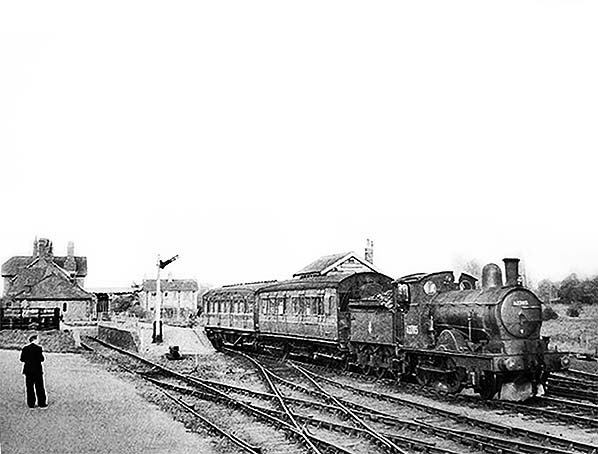 . Class E4 No.62785 departs from Mildenhall with an unidentified service circa early 1957; an ex-GER brake third + Gresley composite set is in use. The ex-GER brakes were withdrawn during 1957 and replaced with Gresley brake thirds. The scissors crossing can be seen in the foreground; it allowed access to the station from the goods yard; to the dock either via the goods yard or the loop avoiding the goods shed. It could also be used for locomotives running around trains and indeed was in the case of goods trains. The lock-up and cattle pen can be seen in the left background.
As is often the case with what came to be termed 'freight-only' lines, anybody wishing to see and photograph the goods train on the Fordham - Barnwell section had to be out and about sharpish as it frequently ran early. It is not known which locomotive operated the final Fordham - Burwell goods. Track-lifting had left one short section of the Mildenhall branch intact: that to the oil terminal between Barnwell and Fen Ditton. The very last passenger train on the Mildenhall branch was a railtour using a DMU during 1991 which visited the oil terminal, which itself became disused during 1994. This last surviving stub remains in situ as of January 2015 but is now disconnected and gated-off at Barnwell Junction.
Otherwise, today all the former Mildenhall branch stations have survived with the exception of Burwell, demolished in 1967, and no trace remains of the three halts. Much of the trackbed has returned to agriculture or has been built upon but some sections do remain. At Mildenhall, the station has been nicely preserved and the goods shed survives whilst from the air the outline of the infilled turntable pit can still be discerned. Many bridges have been demolished and others, such as Exning Road, have been infilled but retain their approach embankments. A brick arch bridge at High Ditch Road (between Fen Ditton and Quy) survives intact as does an iron bridge over a dyke near Lode. See below Fordham station, along with Soham, closed on 13 September 1965 as did Snailwell curve, which removed any possibility of trains running between Ely and Cambridge via Newmarket without a reversal at Chippenham Junction. Fordham signal box closed on 28 October 1973. On a brighter note, E4 locomotive 62785, once familiar on the Mildenhall branch, survived to be preserved, as has Brush Type 2 D5662, the Wickham DMU used on the last day. Four of the five German railbuses have also survived into preservation. The Mildenhall branch has therefore not entirely been forgotten. 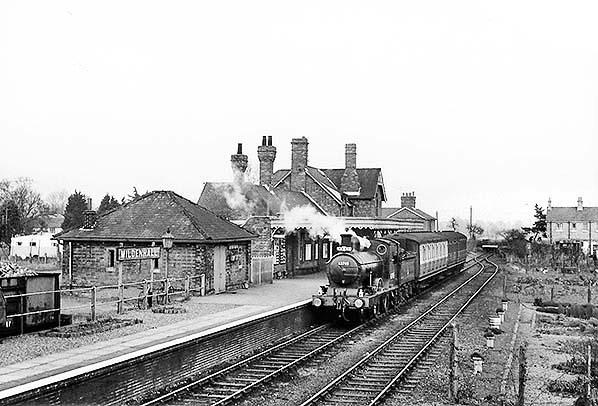 Mildenhall on 28 November 1959. The occasion is a Cambridge University Railway Club special. This view is taken from the signal box and if it were not for the CURC headboard, headcode lamps and apparent lack of passengers, it could have been taken anytime after 1948 - such was the rather timeless nature of the Mildenhall branch in steam days. The open wagon in the dock, left, was one of at least two present that day but not coupled.
Photograph by Peter Jamieson and reproduced with his kind permission
Sources:
|

junction.jpg) On an unknown date in 1956, a rather leaky Class E4 2-4-0 62796 has just left Fen Ditton halt. It is about to pass the connection to the brewery siding, after which it will negotiate the 40 chain curve into Barnwell Junction station. The presence of the brewery siding connection is the reason for the widening of railway land at this point. The photographer is standing on the site of what would become the oil terminal. The E4s began life as GER Class T26 and the first batch of ninety was built between 1891 and 1896. A second batch of ten was built in 1902 with higher boiler pressure and what became BR 62796 was one of this batch. The entire 1902 batch was given 'water cart' tenders when new but over time these tenders became dispersed. Due to drifting steam, it is not clear which type of tender 62796 had when photographed. She was withdrawn in May 1957 from Cambridge shed. The train is formed of one of the ex GER bogie sets which had replaced the 6-wheelers in 1940. An enlargement of the picture shows the retractable steps for use at the halts at just visible but largely obscured by steam. By 1956 much of this stock had been withdrawn, including an ex NER coach which also appeared on the branch, and ordinary stock was sometimes substituted. Because of this, portable steps were provided for use at the halts. This was the origin of these steps and thus they were not, as is commonly assumed, introduced with DMUs and railbuses. The GER stock was replaced for a short time by a dedicated Gresley 3-car set, Set 106, but even this was inconsistent. It often ran as a 2-car set but, again, ordinary vehicles were sometimes substituted and thus also required the portable steps. By 'ordinary' we mean brake-end vehicles not fitted with retractable steps
On an unknown date in 1956, a rather leaky Class E4 2-4-0 62796 has just left Fen Ditton halt. It is about to pass the connection to the brewery siding, after which it will negotiate the 40 chain curve into Barnwell Junction station. The presence of the brewery siding connection is the reason for the widening of railway land at this point. The photographer is standing on the site of what would become the oil terminal. The E4s began life as GER Class T26 and the first batch of ninety was built between 1891 and 1896. A second batch of ten was built in 1902 with higher boiler pressure and what became BR 62796 was one of this batch. The entire 1902 batch was given 'water cart' tenders when new but over time these tenders became dispersed. Due to drifting steam, it is not clear which type of tender 62796 had when photographed. She was withdrawn in May 1957 from Cambridge shed. The train is formed of one of the ex GER bogie sets which had replaced the 6-wheelers in 1940. An enlargement of the picture shows the retractable steps for use at the halts at just visible but largely obscured by steam. By 1956 much of this stock had been withdrawn, including an ex NER coach which also appeared on the branch, and ordinary stock was sometimes substituted. Because of this, portable steps were provided for use at the halts. This was the origin of these steps and thus they were not, as is commonly assumed, introduced with DMUs and railbuses. The GER stock was replaced for a short time by a dedicated Gresley 3-car set, Set 106, but even this was inconsistent. It often ran as a 2-car set but, again, ordinary vehicles were sometimes substituted and thus also required the portable steps. By 'ordinary' we mean brake-end vehicles not fitted with retractable stepsjunction.jpg) Looking north from Newmarket Road bridge at the junction with the Mildenhall branch in May 1976. On the left, the former Barnwell Junction goods yard is now used only by coal merchants and is very obviously no longer rail served. It had closed to rail traffic in 1966. In the distance the long-lived footbridge over the railway can be seen connecting Ditton Meadows, to its right, to Stourbridge Common, to its left. In the far distance can be seen the bridge over the River Cam. Barnwell Junction station although closed for over 10 years remains largely unaltered with the up line remaining in place to serve and oil terminal.
Looking north from Newmarket Road bridge at the junction with the Mildenhall branch in May 1976. On the left, the former Barnwell Junction goods yard is now used only by coal merchants and is very obviously no longer rail served. It had closed to rail traffic in 1966. In the distance the long-lived footbridge over the railway can be seen connecting Ditton Meadows, to its right, to Stourbridge Common, to its left. In the far distance can be seen the bridge over the River Cam. Barnwell Junction station although closed for over 10 years remains largely unaltered with the up line remaining in place to serve and oil terminal.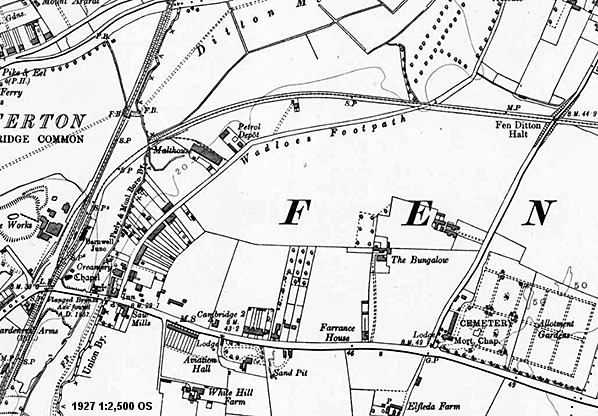
.jpg)

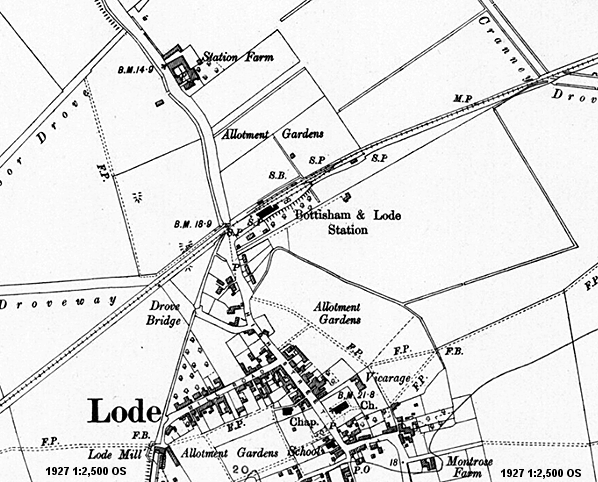
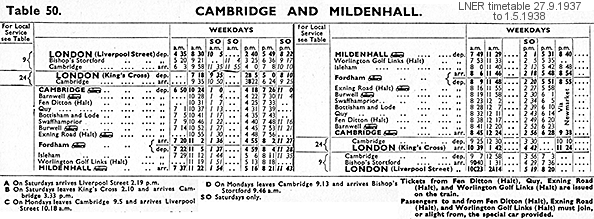
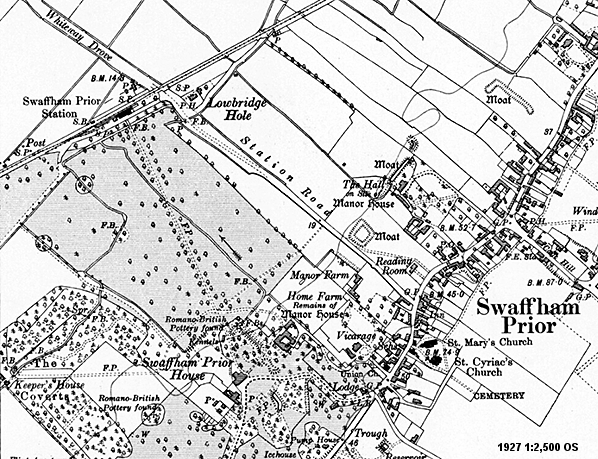
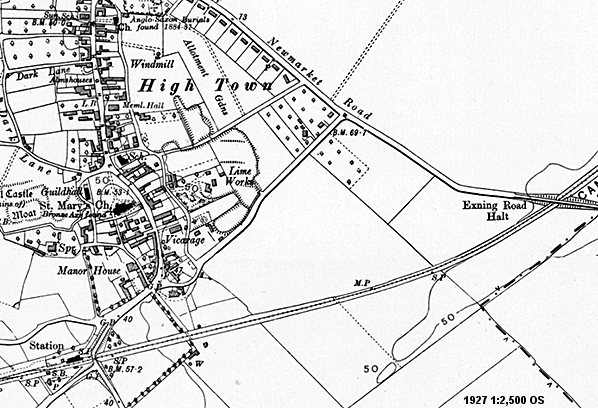
old29.jpg) A view in July 1969 from the down platform looking towards Ely. Note the mirror on the signal box has moved again; this seems to have occurred frequently so presumably provision was made for this.
A view in July 1969 from the down platform looking towards Ely. Note the mirror on the signal box has moved again; this seems to have occurred frequently so presumably provision was made for this.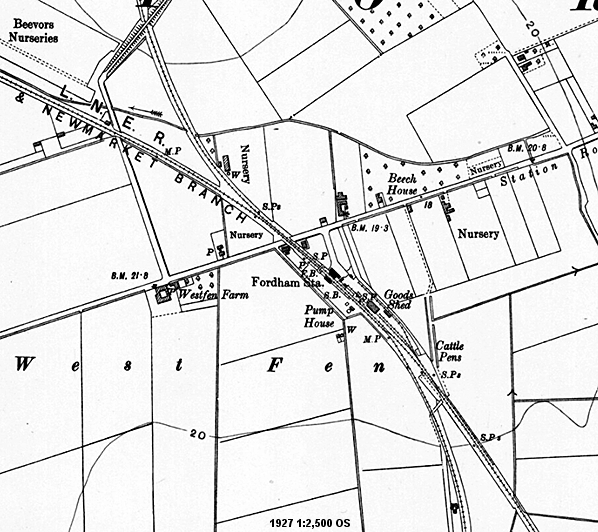
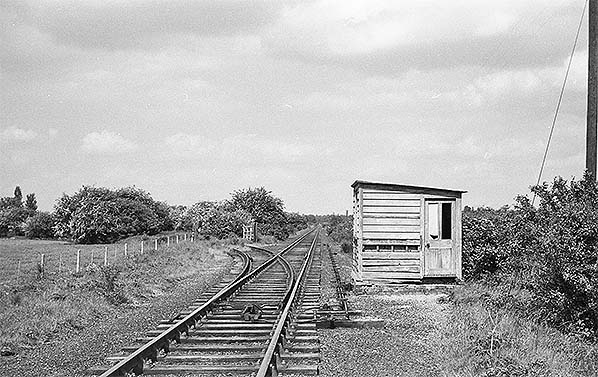
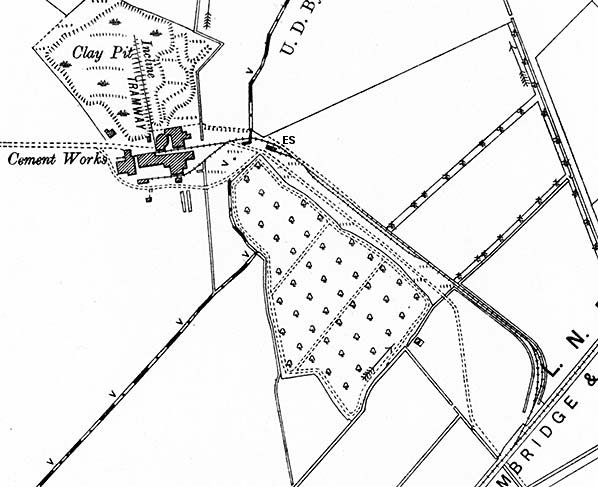
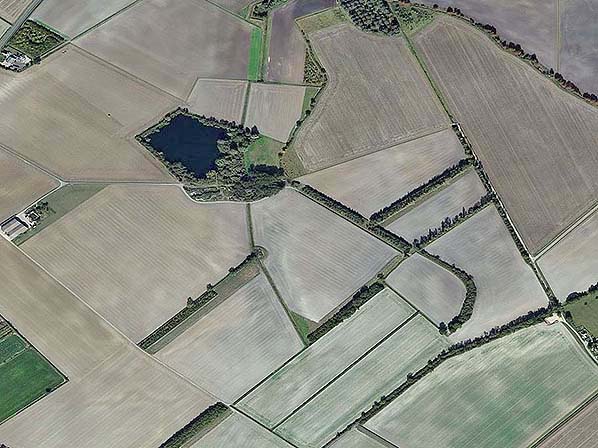
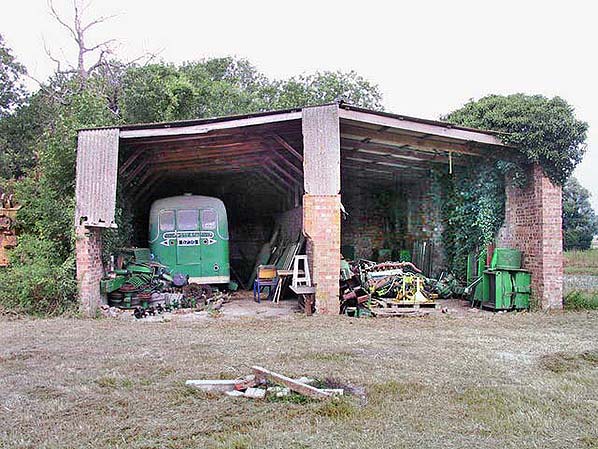
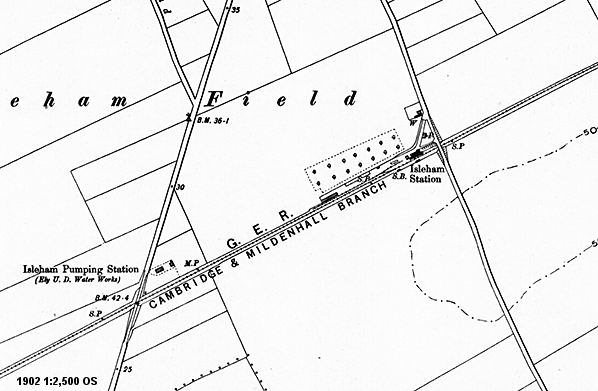
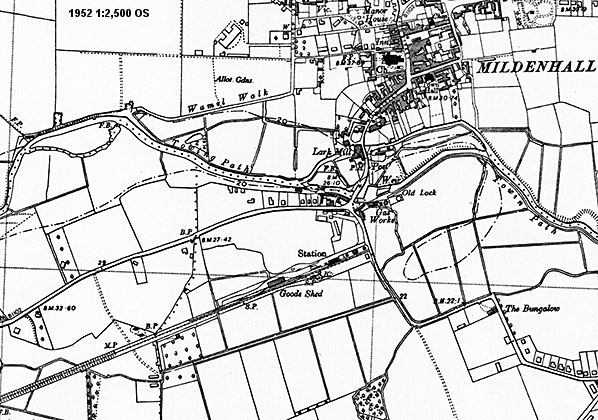
 Photo by James Arnold
Photo by James Arnold

 Home Page
Home Page